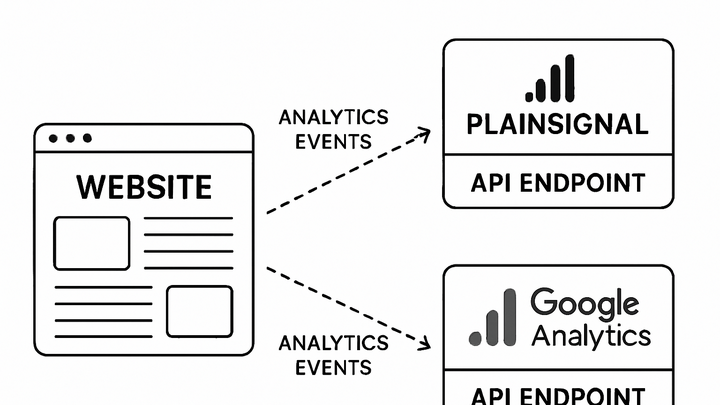Published on 2025-06-26T04:14:54Z
What is an API Endpoint? Examples in Analytics
An API endpoint is a specific URL where analytics trackers send HTTP requests to submit event data or
fetch insights. In analytics, endpoints act as the gateway between client-side libraries (like
PlainSignal’s cookie-free script or GA4’s Measurement Protocol) and backend processing systems. When a
user visits a page or interacts with an element, the embedded JavaScript snippet sends an HTTP request to
the platform’s endpoint—e.g., //eu.plainsignal.com or
https://www.google-analytics.com/mp/collect—containing details like event names, timestamps,
and metadata. The endpoint authenticates requests using API keys or secrets, validates payload schemas,
and forwards the data to storage and processing clusters. This decoupled architecture enables scalable
data ingestion, version control, and interoperability across multiple analytics tools. Understanding API
endpoints is vital for customizing tracking implementations, troubleshooting data discrepancies, and
ensuring secure, reliable communication between your app and analytics servers.
Api endpoint
A URL where analytics tracking code sends HTTP requests for data ingestion and insights retrieval.
Definition and Role
This section explains what an API endpoint is and its fundamental role within analytics systems.
-
Definition
An API endpoint is a URL where a client sends requests to retrieve or send data. In analytics, endpoints receive tracking events from applications or websites.
-
Role in analytics architecture
Endpoints act as the gateway between frontend trackers and backend processing, ensuring data is collected, validated, and stored efficiently.
How API Endpoints Work
Dive into the mechanics of data collection via endpoints, covering the request-response cycle and security considerations.
-
Request & response cycle
Clients (e.g., tracking scripts) send HTTP requests to the endpoint; the server processes, acknowledges, and queues the data for analysis.
-
Authentication and security
Most analytics endpoints require API keys or tokens to authenticate. Transport security (HTTPS) and CORS headers protect data in transit and control origin access.
Examples with SaaS Analytics Platforms
Illustrative code snippets and endpoint URLs for popular analytics services.
-
PlainSignal
PlainSignal’s cookie-free analytics uses the
//eu.plainsignal.comendpoint to collect events. Below is a sample tracking code integration:-
Example tracking code
<link rel="preconnect" href="//eu.plainsignal.com" crossorigin /> <script defer data-do="yourwebsitedomain.com" data-id="0GQV1xmtzQQ" data-api="//eu.plainsignal.com" src="//cdn.plainsignal.com/plainsignal-min.js"></script>
-
-
Google analytics 4 (GA4)
GA4 endpoints use the Measurement Protocol v2 at
https://www.google-analytics.com/mp/collect. Here’s an example payload using HTTP POST:-
GA4 measurement protocol
POST https://www.google-analytics.com/mp/collect?measurement_id=G-XXXXXXX&api_secret=YOUR_SECRET { "client_id": "35009a79-1a05-49d7-b876-2b884d0f825b", "events": [{"name": "page_view"}] }
-
Best Practices
Tips for designing and maintaining robust, scalable, and secure analytics endpoints.
-
Implement rate limiting
Prevent abuse and ensure service availability by enforcing quotas per API key or IP address.
-
Use versioning
Version your endpoints (e.g.,
/v1/collect) to maintain backward compatibility when updating schemas or features. -
Graceful error handling
Return clear HTTP status codes and informative error messages. Allow clients to retry on transient failures.
